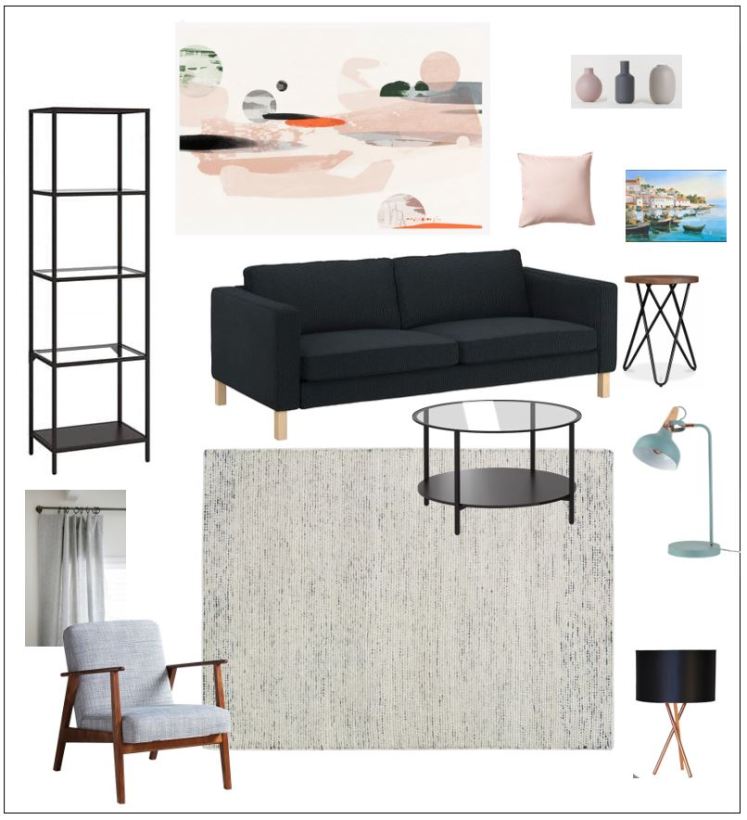Exciting news! I ordered a rug for the living room! I even took measurements of the room before picking a size, so I’m feeling very grown up right now. The old me would see a pretty rug, gasp at the price for the ideal size, and then go for a smaller version. I got away with buying a small rug for our old living room because it was so tiny, but I wanted the correct size for this space.
Rugs are one of those purchases that feels final. Like you better have a design plan that you love, because you’re committed once you buy a rug. Now that I’ve pulled the trigger and made the first purchase for the living room, I thought I’d backtrack a bit to show you the plan, and give some tips for decorating on a budget.

Sources: shelving unit (photo credit) / Cecilia Carlstedt print
lumbar pillow / b&w pillow / pink pillow / vases / sofa / rug / side table / coffee table / lamp / chair
This plan works with a lot of what we have already, but includes a new sofa, rug, and pillows. It’s over our budget, so the plan is happening in budget-friendly stages because this is real life, and we like to spend money on other things like travel and occasionally leaving the house. Here is the more realistic plan: We’re keeping our Karlsted sofa that I dyed black, and just getting the rug for now. I have to say, I’m pleased with this plan. It’s similar to the original, but doesn’t break the bank. Scaling back a vision so that it’s achievable can be difficult, but there are a few methods that make editing design plans easier.
We’re keeping our Karlsted sofa that I dyed black, and just getting the rug for now. I have to say, I’m pleased with this plan. It’s similar to the original, but doesn’t break the bank. Scaling back a vision so that it’s achievable can be difficult, but there are a few methods that make editing design plans easier.
Let first impressions be your guide
To be honest, I started making plans for decorating the house the day we saw it. (I know, but I couldn’t help myself.) I’m glad I did because after seeing it for the first time, I had a clear vision of what I wanted to do. While I don’t advise buying things right away, I do think first impressions are helpful when creating a design plan. I had a strong reaction to the brown carpeting downstairs, so I knew right away that I wanted a rug in the living room. Now that the living room is all unpacked, it’s a bit harder to get a clear vision of what could make it better. It’s a comfortable room, but not as pretty as it could be. I referred back to the pins I saved before we moved when deciding what my plan should be, and it gave me the confidence to go ahead and buy the rug.
Color palette
Using color isn’t one of my strengths, but I once heard some design advice that I think is great for choosing a color palette: look in your closet and decorate with colors you wear. I used to decorate with a lot more color, but it never felt quite right. I don’t wear a lot of color (I love black), so it makes sense that having a super colorful home just isn’t me. Color trends change, so a budget friendly tip is to find out what colors make you most comfortable, and use those for larger more expensive pieces. I prefer to add pops of color with accessories or wall art. If you’re a renter like me, painting the walls might not be an option, but you can always save ideas for later. 🙂
Be flexible
Being flexible makes it much easier (and far less painful) to stick to a budget. If you create a design plan, and it’s not possible to execute all of it right away, then get creative! Don’t be afraid to try something unconventional and move pieces to try them in different spaces. You may be surprised how something looks in an area you had not considered.
Lighting
Have you noticed that I have not one, but TWO lamps in the living room now? I love the option of turning lamps on in the evenings for a cosier atmosphere. Maybe some day we’ll get high tech in here with some smart lighting, and a remote control to change the level of illumination. That might be a job for Andrew 😉

I like how you’re using the painting from your bedroom in you previous home to bring color into the living room.